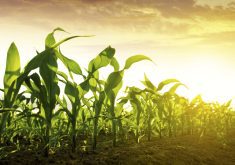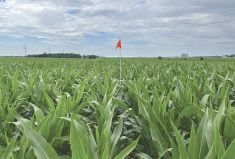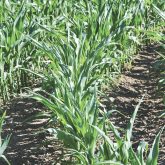Farming in Quebec typically calls to mind those long, narrow ribbons of land that run inland from the St. Lawrence River. But that’s not the reality that Billy Beaudry and his family face on their farm about a third of the way toward the U.S. border, on a plateau between the St. Lawrence and the Appalachian Mountains.
The Quebec stereotype (like farm stereo-types all across Canada) might also call for a farmer who is a grey-haired veteran steeped in tradition.
As you’ll see, that isn’t his reality either.
Read Also

Sensing the soil: Root cell research finds ‘stress hormone’
Research into how root cells react to soil stressors could help plants better adapt to changes in their climate.
Beaudry and his family are based near Saint-Valérien-de-Milton, about 20 minutes southeast of Saint-Hyacinthe, just east of Montreal. Billy is a third-generation farmer and graduated from McDonald College at McGill University in 2006. His uncle took over the family dairy operation, so when Billy’s father Alain started farming in 1982, he began with a small sow barn and then started purchasing more land to go with it.
Today, the family operates on roughly 1,500 acres, with mostly corn and soybeans grown on the plateau’s variable ground, where soil types frequently change within individual fields.
The Beaudrys also do some sharecropping, usually based on wheat although there have been years where they have turned to barley and oats, with the occasional contracts for seed oats. In addition to the cropping operation, the family has kept their hands in the pork industry, operating Beau Porc, a 100-sow farrow-to-finish operation with as many as 2,100 finishing hogs under contract.
Keeping everything manageable is a complex process, yet the focus on the farm seems to be on finding operating efficiencies, including working with a relatively small group of full-time employees. In all, there are four members of the family who work on the farm: Billy, his parents, Alain and Sylvie, and his sister, Cindy. During spring planting and fall harvest, they also bring in as many as four seasonal employees to help with the duties.
In addition to juggling crops and livestock, Beaudry says the soil variability is one large challenge, and the weather often makes it even tougher.
“Even though all of our land is tiled drained, we do a lot of surface drainage every year,” Beaudry says. “We are working with an RTK system to make some topographical maps to level our soil. But it still seems as though the rain events are a lot bigger than they used to be.”
Frost is slow to leave such soils, so even though low commodity prices can increase the incentive for getting a good start, the reality of spring weather can make things very difficult.

Land prices not the same impact
Just as prices for land are on the rise across the country, it’s the same in Quebec. Beaudry knows of two neighbours who were vying for the same piece of land. The bidding process escalated before the deal finally closed for nearly $22,000 per acre.
“We can only plant 2700 or push it to 2800 heat-unit corn,” says Beaudry. “It’s not like in the Saint-Hyacinthe area where the soils are great and it drains the water so well, and they usually have a half a tonne per acre more yield than we do, doing the same kind of work.”
He expects regional land prices will ease, either coming down slightly or at least staying relatively stable. In the meantime, Beaudry says he continues to look to improve efficiencies on his farm, using new technologies and systems, as well as learning from other growers in his area.
“The most important thing is that when we do try something, we try it as a side-by-side comparison, so we know what’s going on,” he says. “If it’s valuable, then we know how much more money we’re making, and if it’s not, it helps to understand why it didn’t work. It’s more a matter of trying to get the idea of what other people are doing that’s good, and trying to replicate it on our farm.”
2015 is also the fourth year the Beaudrys have been using the GreenSeeker technology, trying it first in 2012 in side-by-side comparisons in two fields with their dry fertilizer applicator. In those trials, Beaudry says they could see the technology was working, but to get the full potential, they had to apply later in the season. That’s when they decided to go with the Y-Drop system and found it to be the perfect companion to the GreenSeeker units.
“With that technology, we’ve changed the way we’re fertilizing our crops now, and we’ve learned a lot, too, because even with the rain we have, we’ve been side dressing for a long time,” says Beaudry, noting that his father started the practice about 15 years ago. “But during trials, we realized that sometimes we’re probably not putting down enough N early in the season, and then we would come back too late, and that would cost us a bit of yield. Now we have a starter at about 50 kg of N per hectare (roughly 47 lbs. of N per acre) and then we come back at the two-leaf stage and add another 50 kg of N per hectare. So mainly half of our nitrogen is put down early, and after that, I go with the Y-Drop and the GreenSeeker system at the 12-leaf stage, at least.”
The move to more intensively evaluating new technologies on the family farm has also encouraged better tracking of crop histories. Based on in-season monitoring, Beaudry and his family have a better idea of what to expect in the fall. Use of basic GPS technology and the GreenSeeker system allows him to keep better records and then try to narrow the focus on particular parts of the field according to specific soil types.
Importantly, by developing more precise plans, Beaudry is able to get closer to maximizing crop production and reducing the costs that go with it.
“It’s also great for record-keeping and making things simpler, always calculating our cost of production for every field, every year, so we know where to go after,” he explains. “We always try for better yields — that’s the main thing for us. But we’re also taking a good look at our cost of production, to make sure we’re not buying those yields. That’s our goal every year — to beat our record year — but at the same time, we’re slowly trying to move towards more reduced tillage.”
Quebec farmers have it “covered”
The Beaudrys also make use of cover crops, wherever and whenever possible, including into corn. There are some in his region who do more with cover crops but Beaudry is well experienced with ryegrass given the soils and types of drainage he has on his land. Again, depending on the year and the crop rotation, he likes to spread seed early, seeding into corn after the second glyphosate application, around the five- to six-leaf stage.
And he always grows a cover crop after his wheat, noting that there’s more time to do what he wants in advance of seeding. If it’s a sharecrop, he can level the land, put down some manure followed by lime, and then subsoil everything, after which he can plant ryegrass or blend it with oilseed radish. In 2014, he also tried peas in the mix, acknowledging that the seed is a little more expensive, but that he’s been told it can reduce nitrogen costs.
“It’s kind of a trial that we’ll see this year, if the part of the field that had some peas on it last year has even better yields in corn, and if I can put less nitrogen and reduce my costs,” says Beaudry. “We’ll see how it goes.”
Slow and steady
For now, Beaudry, his parents and his sister take a more methodical approach of managing their farm. They’ll assess any new trend or practice, performing the side-by-side comparisons that provide reasonably conclusive results, and find the right fit for their operation — first and foremost.
Although he sees himself as open minded and willing to try new things, it’s always with the same “slow and steady” approach. It’s easy, he has found, to get caught up in the trap of buying newer and bigger technology without first determining a system’s cost-benefit.
It’s also important to share information, he believes. Beaudry was among the first in Quebec to use the Y-Drop system, often hosting other farmers to see first hand what the system can do.
“We think we still have some things to maximize on the land we have,” says Beaudry, adding that their goal is to be sustainable while casting an eye on the future (he has two children and another on the way, and his sister has a son and is considering having another) and a desire to keep farming in the family. “We want to be ready if there are a lot of people interested in farming. Obviously in the long term, we think about increasing the size, but we’re not in a big rush because now it doesn’t make sense. You have to capture your net income to have more land.”
This article first appeared in the September 2015 issue of the Corn Guide
















